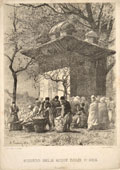(Busseto 1826 - Cavoretto 1899)
TRANSIT OF A CARAVAN THROUGH THE MOUNTAINS BETWEEN PERSIA AND KHORASAN, c. 1859
Black chalk, signed A. Pasini in pen and brown ink at bottom left; 159 x 297 mm. The drawing, unpublished, is preparatory to the homonymous painting exhibited at the Salon in Paris in 1859. In her monograph of 1991, Vittoria Botteri Cardoso published another drawing connected with that painting, but with less precision. See Vittoria Botteri Cardoso, Pasini, Genoa 1991; cat. nos.173.1 and 173.2.
Alberto Pasini was one of the most popular Italian painters of oriental scenes during the late nineteenth century. Born in the small town of Busseto, near Parma, he studied at the Accademia in Parma, where he learned lithography. From 1851 to 1853, he studied in Paris with Eugène Cicéri, a French lithographer and landscapist. During this period, he was influenced by the romantic oriental painter Eugène Fromentin. The Barbizon landscapists Eugène Isabey and Théodore Rousseau also greatly influenced Pasini, who exhibited for the first time in the Salon of 1853. Pasini travelled throughout the Middle East, especially to Turkey, Persia, Syria, and Egypt. Alberto Pasini's work found great official acceptance, and he won many awards, including the chevalier of the Légion d'Honneur in 1868, and officer of the Légion in 1878.


